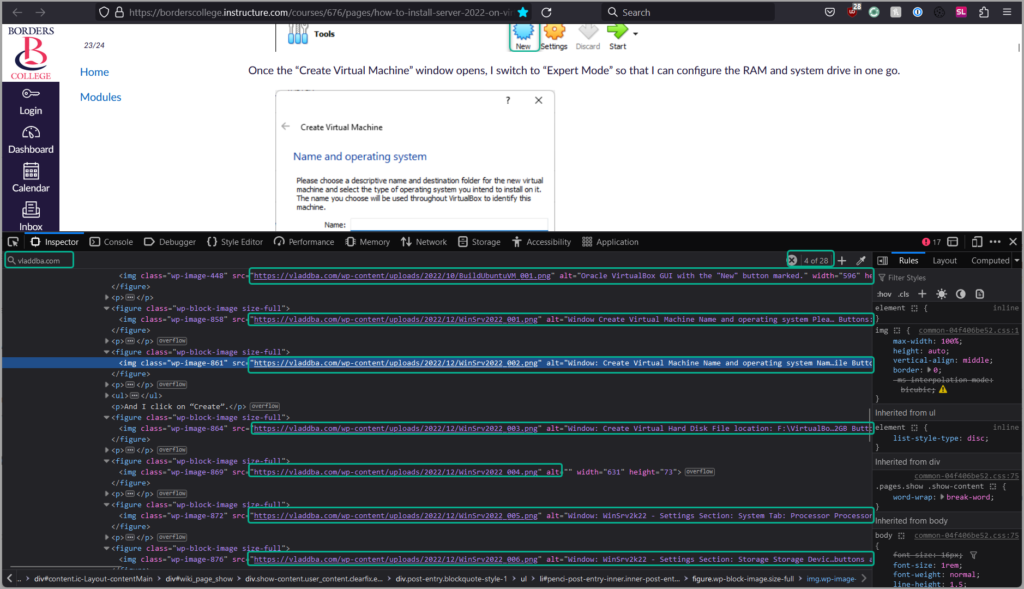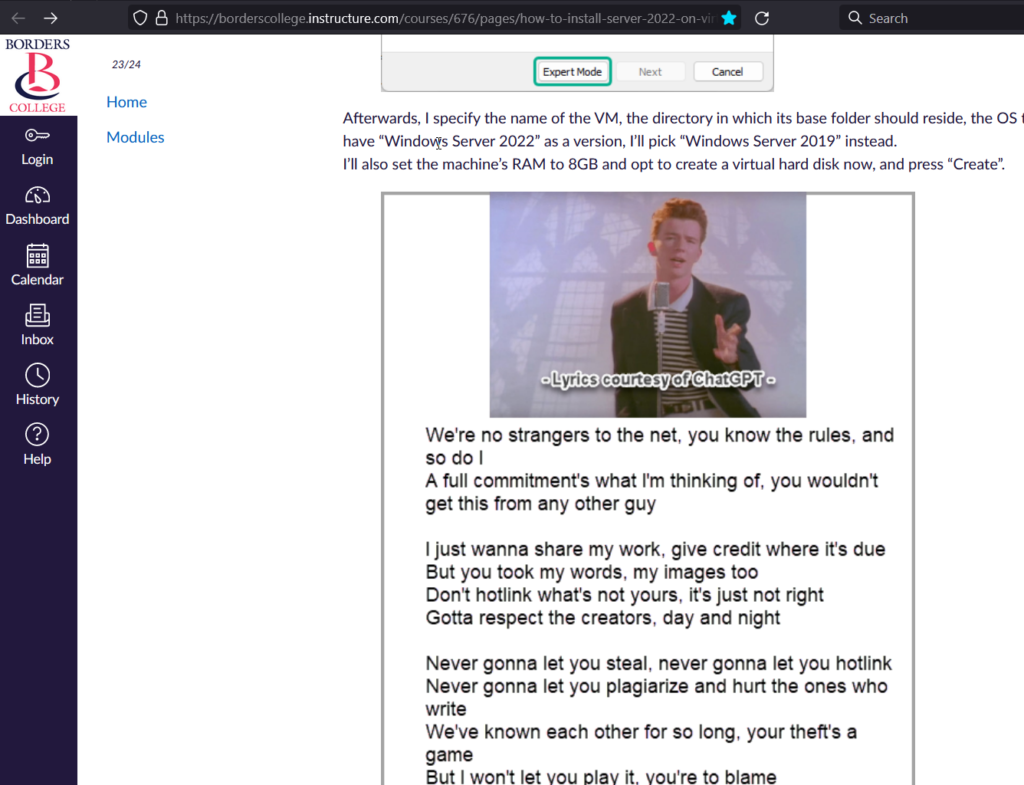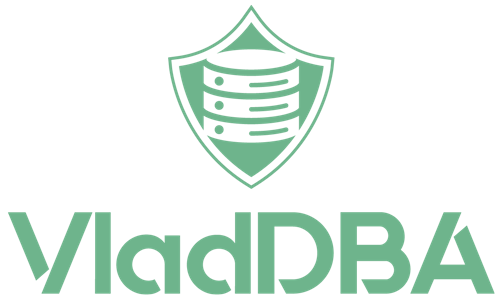Today I’ll deviate a bit from my usual SQL Server posts, and address plagiarism while also offering a valuable lesson in why hotlinking images is a terrible idea and a college providing a cybersecurity course, of all things, should know better.
There’s a lot of irony at play here, so I recommend listening to Alanis Morissette – Ironic while reading this post.
Backstory
Back in 2022 I’ve written this blog post going over my process of setting up a Windows Server 2022 VM in VirtualBox.
Yesterday (2024-02-17), while I was checking AWStats for my blog, I’ve noticed an interesting entry in traffic coming from external pages.
These are records of visits your site gets from users that have clicked a link, that points to your site, on another site. For example when I share blog post on LinkedIn, I’ll see all the traffic from that post as coming from https://www.linkedin.com.
The entry that caught my attention was this one.
![Links from an external page (other web sites except search engines) Total: 17 different pages-url https://www.linkedin.com [rest of the entries redacted] https://borderscollege.instructure.com/courses/676/pages/how-to-install-server-2022-on-virtualbox https://borderscollege.instructure.com](https://vladdba.com/wp-content/uploads/2024/02/BordersCollegeStealsContent_000-1024x193.png)
Based on the URL alone, I took it as a compliment, thinking that a college linked to my content in one of its courses.
Clicking on the URL marked in the screenshot revealed something unexpected and upsetting.
Borders College plagiarizes content
That course entry is, with the exception of one photo at the end of the course and some text removed (marked in the below screenshot), an identical copy of my blog post.


I’m not going to make a screenshot comparison of the whole page since, at this point, dear reader, you get the idea.
But, for evidence purposes, I did save that page on the Internet Archive, and you can see it here.
On a side note, please donate, if you can, to the wonderful over at the Internet Archive.
Now, in case there are any doubts, the course makes no mention of me as the author said content.
Nor have I ever been contacted by someone representing Borders College requesting permission to use any of my content.
As someone who has never graduated university, the irony of one copying my content and including it in their courses is not lost on me.
Since there is no mention of my blog post as being the source of that course entry, this leaves the question of “how exactly am I getting traffic from there?”
Why host their own images when I already host them?
I use FireFox’s Element Inspector to check what exactly in that page points to my blog.

And it turns out that the hits that my blog is getting stem from the fact that Borders College decided to forgo on downloading the images from my post and hosting them themselves, and just opted to hotlink to my images.
Understandable, I’m already paying for the storage space and caching, so they might as well save a dime.
Not to mention that most my images also contain alt text for accessibility purposes, so they don’t have to bother with adding their own alt text.
What’s hotlinking?
Inline linking (aka hotlinking) is the use of a linked object on one site by a web page belonging to a second site. One site is said to have an inline link to the other site where the object is located.
https://en.wikipedia.org/wiki/Inline_linking
Why is hotlinking a tremendously bad idea?
If you’re hotlinking, you have zero control over the hotlinked content.
This means that, if the content owner wants to, they can swap out that content right from under you.
At this point you might see how this can lead to some very unpleasant problem.
Best case scenario: I give up on blogging and just delete everything. Leaving Borders College with a bunch of missing images for that course.
Worst case scenario:
An attacker gains control of my blog and decides to upload some unsavory images in the same paths with the same file names, then those images will be shown on Borders College’s course.
There’s some irony in this too – the plagiarized content and hotlinked images happen to be part of Borders College’s Cybersecurity class.
Am I the only one whose content ended up as Borders College’s course content?
Probably not.
A couple of examples:
- Their Server 2019 – Domain Controller Setup Guide content is straight from here, complete with hotlinked images. – Internet Archive snapshot of that page just because.
- Their Crossover vs Straight Through Cables content is from here, with the same image hotlinking. – Internet Archive snapshot.
And those are just two examples because I still want to enjoy what’s left of my Sunday instead of playing internet detective.
Note, this is just a suspicion based on what they did with my content. I can’t say for sure if they’ve actually bothered to ask those authors for permission to use their content or not.
Don’t colleges and universities have a policy about plagiarism?
Why indeed they do.
Even Borders College makes a mention of this in the “Acceptable Use of the Internet” section of their T&C page.

The annoying part with this is that generally, in academia, only students are held responsible when it comes to plagiarism, while professors not so much. Weird double standard, isn’t it?
A teachable moment for Borders College
Before I proceed I want to make a couple of things clear:
- The content that I’m changing is mine. They are screenshots that I’ve taken, documenting things I have done in my own lab environment, and they’re hosted on services that I pay for. So modifying them however I please is my right.
- Borders College could have avoided this if they would have:
- mentioned the source of their course
- reached out to me (those social links over there are fully functional) beforehand and asked if I’m ok with citing my work in their course. I would have freely and gladly accepted.
Now that I got that out of the way, I’ve realized that maybe I should update one of the images in my Setting up a Windows Server 2022 VM in VirtualBox blog post.
I’ve made this image with a photo of Rick Astley and some lyrics generated by ChatGPT about plagiarism and hotlinking, and I’m thinking of adding it to my old blog post.

Since I’m a stickler for organizing files in the correct directories for their blog posts, I want to upload it to the same directory where all the images for that specific blog post are stored – https://vladdba.com/wp-content/uploads/2022/12/
So I’ll have to use cPanel’s File Manager to move the newly uploaded image in the desired directory.
The other problem is that the image has the same file name as an already existing image in that post – WinSrv2022_002.png

But I really want the new photo to have that specific file name.
Since no decent file system allows for two files with the same name and extension to coexist in the same directory, my only option is to rename the existing image in File Manager before I upload the new one.
I’ll rename it to WinSrv2022_002orig.png.
And then, I upload the other image and, from File Manager, move the images to the specific directory.

I’ve eventually decided to not include the new image in my old blog post, but I’ve left it in that directory since since it can’t do any harm
But, as you can see in this screenshot, the image I’ve made, now lives in this path.

Now, because Borders College hotlinked my images, I wonder if this change has any impact, that I have no control over, on their course material?

The Internet Archive snapshot can be found here, just in case.
Update
At this point (2024-02-22) I have yet to be contacted by anyone representing Borders College.
But the following things have happened:
- 2024-02-19 – Borders College blocked me on Facebook after tagging them in the exact same post I’ve made on LinkedIn
- 2024-02-20 – I’ve done the same steps as described above for an image named WinSrv2022_003.png – Internet Archive snapshot – contains a URL leading to this blog post
And Borders College advertised their Cyber Security classes on LinkedIn – adding to the irony of the whole istuation - 2024-02-21 – same steps with another image WinSrv2022_005.png – which contains an URL leading to the blog post that Borders College ripped off
- 2024-02-22 (now) – I was feeling nostalgic so I’ve added the following image as WinSrv2022_002.png

Current number of hits to my hosted images from the Borders College URL https://borderscollege.instructure.com/courses/676/pages/how-to-install-server-2022-on-virtualbox has surpassed 1.3k.

Next steps
I’ve just tagged Pete Smith, the college’s Principal and CEO (since when do colleges have CEOs?), in a comment to my original LinkedIn post.
Conclusion
Do better, Borders College.
Also, I doubt that this is a singular occurrence, but more a sign of a broader issue with Academia plagiarizing external content while, at the same time, imposing strict standards for their students.
I’ve also posted about this on LinkedIn.
